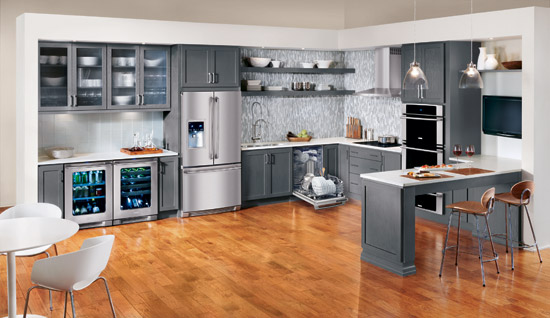Using Built-in Appliances to Enhance Design
Specifying Performance Criteria in Appliances
When specifying appliances, there are two fundamental performance criteria that should be addressed the first is how much energy they use to operate since they all require some on an ongoing basis. The second is for water consuming appliances and is simply a measure of how much water they require to operate—particularly heated water.
 |
Specifying ENERGY STAR® appliances reduces operating usage and cost for energy and water without compromising design quality or other features. Photo courtesy of Electrolux |
Energy and Water Efficiency with the ENERGY STAR® Program
ENERGY STAR® is a well-known program of the U.S. Environmental Protection Agency (EPA) that provides a government-backed symbol for energy efficiency. It is intended to help consumers save money and protect the environment through energy-efficient products and practices. According to their web site, the ENERGY STAR label was established to “reduce greenhouse gas emissions and other pollutants caused by the inefficient use of energy and make it easy for consumers to identify and purchase energy-efficient products that offer savings on energy bills without sacrificing performance, features, and comfort.”
Kitchen and laundry appliances are a significant category of products within the ENERGY STAR program. Manufacturers can submit their information for review and verification by the EPA that they meet the requirements of the program in order to earn a coveted ENERGY STAR label. To qualify, appliances must minimally incorporate advanced technologies that use 10 to 50 percent less energy and water than standard models. In addition, all products need to demonstrate compliance with the following guiding principles as described by the EPA:
• Product categories must contribute significant energy savings nationwide.
• Qualified products must deliver the features and performance demanded by consumers, in addition to increased energy efficiency.
• If the qualified product costs more than a conventional, less-efficient counterpart, purchasers will recover their investment in increased energy efficiency through utility bill savings, within a reasonable period of time.
• Energy efficiency can be achieved through broadly available, non-proprietary technologies offered by more than one manufacturer.
• Product energy consumption and performance can be measured and verified with testing.
• Labeling would effectively differentiate products and be visible for purchasers.
Note that the specific criteria for achieving an ENERGY STAR rating for appliances is regularly updated and can change from year to year. In fact a significant change and upgrade for rating appliances is anticipated during 2014. Note too that specific individual models of appliances are rated, not entire brands of appliances. When specifying appliances it is currently appropriate to call for ENERGY STAR ratings on refrigerators, dishwashers and clothes washers. However the program does not currently rate cooking appliances or clothes dryers so specifications should reflect this accordingly. For all of these reasons, the ENERGY STAR website or printed reports should be consulted to determine if a particular appliance is rated or not. In addition, there are many other resources available, including those listed at the end of this article, so architects can readily find information to specify energy efficient and environmentally responsible appliances of all types.
Water use in appliances has become enough of an issue that the EPA is reportedly working on a water efficiency labeling program, similar to the ENERGY STAR® labeling program. Some ENERGY STAR models use half as much water as others, saving hundreds of gallons of water each year and corresponding savings in energy use. For example since about 60% of the energy used by a dishwasher goes towards heating the water, models that use less water also use less energy. Check the manufacturer's literature for ratings and water use on different makes and models. In some states, electric and water utilities offer rebates for the purchase of models that are exceptionally efficient.
Conclusion
Residential kitchen and laundry areas require high degrees of functionality to suit the needs of owners and occupants. They are also very visible areas that require high design standards since they can be very notable focal points of the residence. Built-in appliances address both the functional needs and the design needs with a wide variety of options and choices that allow for truly custom design solutions based on standardized construction and installation techniques. Architects that embrace kitchen planning principles and understand the depth and breadth of built-in appliance choices can use this knowledge to create truly outstanding designs that enhance and highlight the entire building design.
References: Green Design and Energy Saving Resources for Residential Appliances
• ENERGY STAR® is a government-backed program helping businesses and individuals protect the environment through superior energy efficiency. ENERGY STAR® program information and rated appliances models are found at www.energystar.gov
• U.S. Green Building Council (USGBC) and Leadership in Energy and Environmental Design (LEED) Standards are found at www.usgbc.org
• National Association of Homebuilders (NAHB) represents residential builders nationwide. www.nahb.org
• Enterprise Foundation and information on the Green Communities Initiative. www.enterprisefoundation.org
• American Council for an Energy-Efficient Economy (ACEEE) is a nonprofit organization dedicated to advancing energy efficiency and promoting economic prosperity and environmental protection. www.aceee.org
• Association of Home Appliance Manufacturers (AHAM) provides market industry trends on appliances. www.aham.org
• Appliance Recycling Information Center (ARIC) provides information on recycling appliances. www.aham.org/aric
• Consumer Reports' rates appliances. www.ConsumerReports.org
• Rocky Mountain Institute addresses energy and consumer issues. www.rmi.org
• The Green Guide is a GreenBiz news affiliate. http://www.thegreenguide.com
• Greenbuilder.com is an online resource with information about building and appliances. www.greenbuilder.com
 |
Electrolux is a global leader in household appliances and appliances for professional use, selling more than 50 million products to customers in more than 150 markets every year. The company focuses on innovations that are thoughtfully designed, based on extensive consumer insight, to meet the real needs of consumers and professionals. www.electroluxappliances.com |








